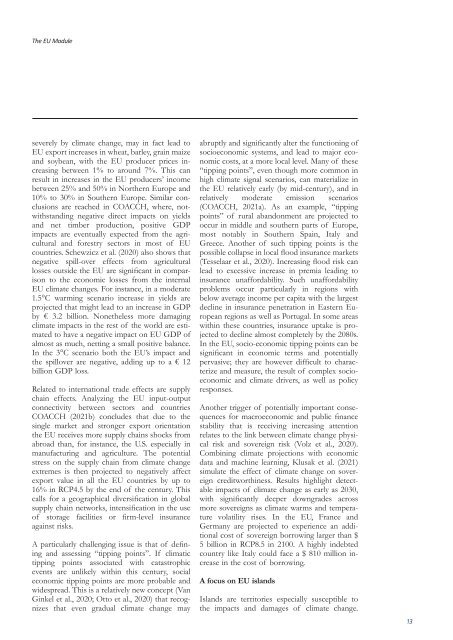EAERE Magazine - N.16 Spring 2022__
Create successful ePaper yourself
Turn your PDF publications into a flip-book with our unique Google optimized e-Paper software.
The EU Module<br />
severely by climate change, may in fact lead to<br />
EU export increases in wheat, barley, grain maize<br />
and soybean, with the EU producer prices increasing<br />
between 1% to around 7%. This can<br />
result in increases in the EU producers’ income<br />
between 25% and 50% in Northern Europe and<br />
10% to 30% in Southern Europe. Similar conclusions<br />
are reached in COACCH, where, notwithstanding<br />
negative direct impacts on yields<br />
and net timber production, positive GDP<br />
impacts are eventually expected from the agricultural<br />
and forestry sectors in most of EU<br />
countries. Schewzicz et al. (2020) also shows that<br />
negative spill-over effects from agricultural<br />
losses outside the EU are significant in comparison<br />
to the economic losses from the internal<br />
EU climate changes. For instance, in a moderate<br />
1.5°C warming scenario increase in yields are<br />
projected that might lead to an increase in GDP<br />
by € 3.2 billion. Nonetheless more damaging<br />
climate impacts in the rest of the world are estimated<br />
to have a negative impact on EU GDP of<br />
almost as much, netting a small positive balance.<br />
In the 3°C scenario both the EU’s impact and<br />
the spillover are negative, adding up to a € 12<br />
billion GDP loss.<br />
Related to international trade effects are supply<br />
chain effects. Analyzing the EU input-output<br />
connectivity between sectors and countries<br />
COACCH (2021b) concludes that due to the<br />
single market and stronger export orientation<br />
the EU receives more supply chains shocks from<br />
abroad than, for instance, the U.S. especially in<br />
manufacturing and agriculture. The potential<br />
stress on the supply chain from climate change<br />
extremes is then projected to negatively affect<br />
export value in all the EU countries by up to<br />
16% in RCP4.5 by the end of the century. This<br />
calls for a geographical diversification in global<br />
supply chain networks, intensification in the use<br />
of storage facilities or firm-level insurance<br />
against risks.<br />
A particularly challenging issue is that of defining<br />
and assessing “tipping points”. If climatic<br />
tipping points associated with catastrophic<br />
events are unlikely within this century, social<br />
economic tipping points are more probable and<br />
widespread. This is a relatively new concept (Van<br />
Ginkel et al., 2020; Otto et al., 2020) that recognizes<br />
that even gradual climate change may<br />
abruptly and significantly alter the functioning of<br />
socioeconomic systems, and lead to major economic<br />
costs, at a more local level. Many of these<br />
“tipping points”, even though more common in<br />
high climate signal scenarios, can materialize in<br />
the EU relatively early (by mid-century), and in<br />
relatively moderate emission scenarios<br />
(COACCH, 2021a). As an example, “tipping<br />
points” of rural abandonment are projected to<br />
occur in middle and southern parts of Europe,<br />
most notably in Southern Spain, Italy and<br />
Greece. Another of such tipping points is the<br />
possible collapse in local flood insurance markets<br />
(Tesselaar et al., 2020). Increasing flood risk can<br />
lead to excessive increase in premia leading to<br />
insurance unaffordability. Such unaffordability<br />
problems occur particularly in regions with<br />
below average income per capita with the largest<br />
decline in insurance penetration in Eastern European<br />
regions as well as Portugal. In some areas<br />
within these countries, insurance uptake is projected<br />
to decline almost completely by the 2080s.<br />
In the EU, socio-economic tipping points can be<br />
significant in economic terms and potentially<br />
pervasive; they are however difficult to characterize<br />
and measure, the result of complex socioeconomic<br />
and climate drivers, as well as policy<br />
responses.<br />
Another trigger of potentially important consequences<br />
for macroeconomic and public finance<br />
stability that is receiving increasing attention<br />
relates to the link between climate change physical<br />
risk and sovereign risk (Volz et al., 2020).<br />
Combining climate projections with economic<br />
data and machine learning, Klusak et al. (2021)<br />
simulate the effect of climate change on sovereign<br />
creditworthiness. Results highlight detectable<br />
impacts of climate change as early as 2030,<br />
with significantly deeper downgrades across<br />
more sovereigns as climate warms and temperature<br />
volatility rises. In the EU, France and<br />
Germany are projected to experience an additional<br />
cost of sovereign borrowing larger than $<br />
5 billion in RCP8.5 in 2100. A highly indebted<br />
country like Italy could face a $ 810 million increase<br />
in the cost of borrowing.<br />
A focus on EU islands<br />
Islands are territories especially susceptible to<br />
the impacts and damages of climate change.<br />
13













